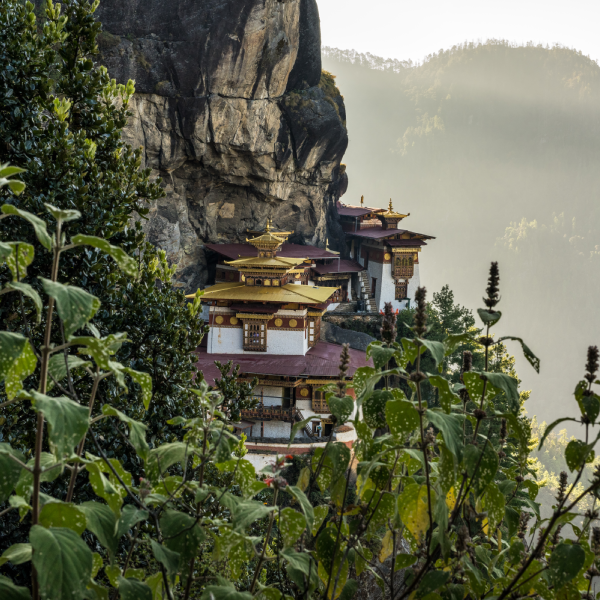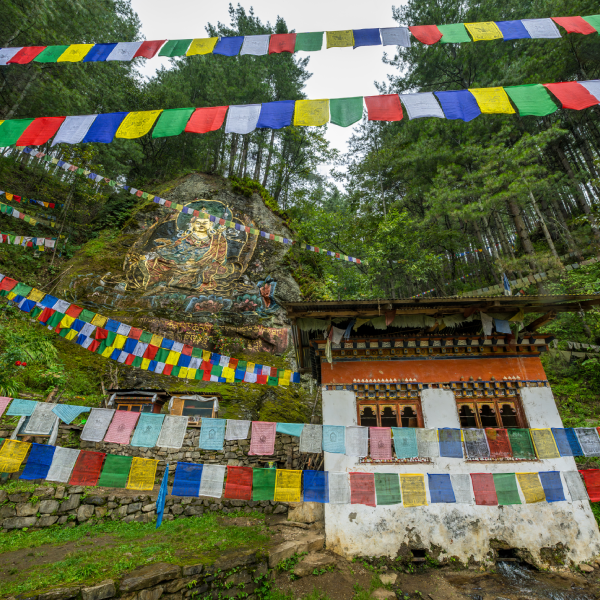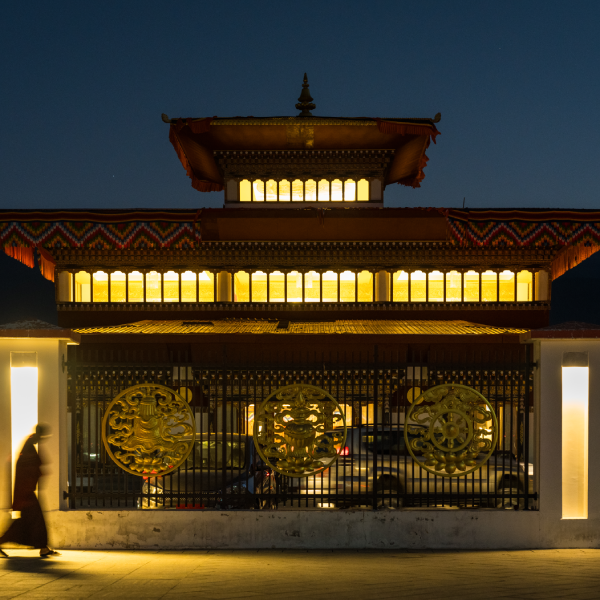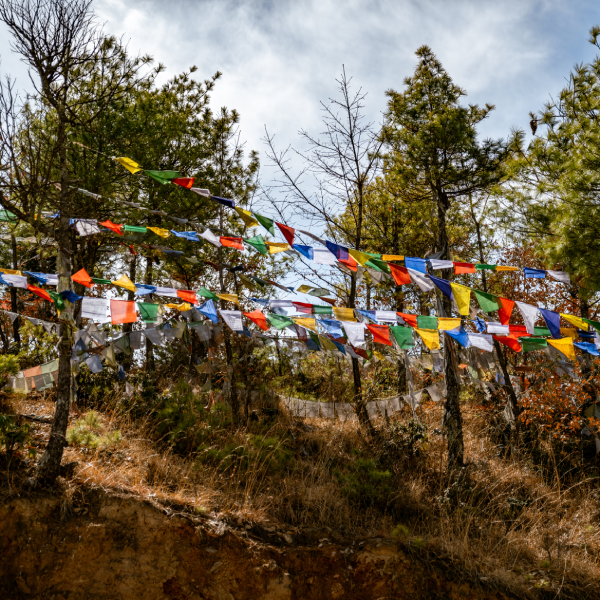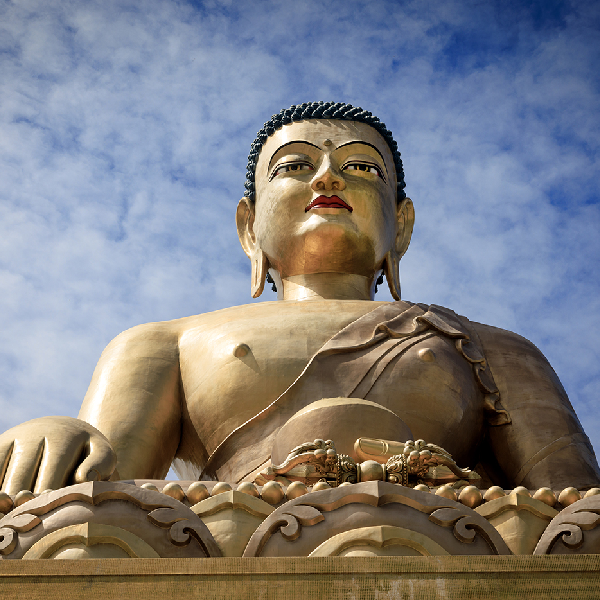Glimpse of Bhutan 8Nights 9Days
Glimpse of Bhutan 8Nights 9Days
Bhutan, known as the "Land of the Thunder Dragon," is a small, landlocked country in the eastern Himalayas, bordered by India to the south, east, and west and China to the north. Bhutan is renowned for its breathtaking natural beauty, rich cultural heritage, and unique approach to governance and well-being. The country's stunning landscapes encompass soaring mountains, lush forests, and pristine rivers, making it a haven for trekking and outdoor enthusiasts. Bhutan's culture is deeply rooted in Buddhism, and its monasteries, dzongs (fortresses), and prayer flags are integral to daily life. Gross National Happiness (GNH) is a guiding principle in Bhutan, emphasizing the well-being and happiness of its citizens over material wealth. Bhutan's monarchy, under the leadership of King Jigme Khesar Namgyel Wangchuck, has guided the nation through a transition to democracy while preserving its cultural heritage. Visitors to Bhutan can explore ancient monasteries, enjoy colorful festivals, and immerse themselves in a culture that values tradition and spirituality. Bhutan's commitment to environmental conservation and sustainable development has earned it a reputation as one of the world's most environmentally conscious nations. With its unique blend of culture, spirituality, and natural beauty, Bhutan remains a remarkable destination.
Short Itinerary
|
Day |
Program |
Accommodation |
Meal |
|
Day 1 |
Arrive in Paro. Drive to Thimphu.53Kms (1 hrs. Drive approx.) |
Hotel |
[-/L/D] |
|
Day 2 |
Sightseeing in Thimphu |
Hotel |
[B/L/D] |
|
Day 3 |
Drive to Punakha. 76kms (3 -4 hrs. Drive approx.) |
Hotel |
[B/L/D] |
|
Day 4 |
Drive to Gangtey. 91kms (4-5 hrs. Drive approx.) |
Hotel |
[B/L/D] |
|
Day 5 |
Sightseeing in Gangtey |
Hotel |
[B/L/D] |
|
Day 6 |
Drive to Punakha. 91kms (4-5 hrs drive approx.) |
Hotel |
[B/L/D] |
|
Day 7 |
Drive to Paro 143kms (3-4 hrs. Drive approx.) |
Hotel |
[B/L/D] |
|
Day 8 |
Sightseeing in Paro. |
Hotel |
[B/L/D] |
|
Day 9 |
Final Departure |
[B/L/-] |
Things to Know
- Travel Times: Bhutan's roads can be winding, especially in the hills. Expect scenic but sometimes longer drives than anticipated.
- Altitude: The highest altitude you’ll reach is around 3,150 meters at Dochula Pass. It’s important to stay hydrated and avoid overexertion, especially during hikes.
- Cultural Experiences: Bhutan is rich in Buddhist culture. Expect to visit monasteries, dzongs, and temples, and you may be asked to follow dress codes (like covering shoulders and knees) when visiting sacred sites.
- Physical Fitness: The hike to Taktsang Monastery on Day 8 can be challenging, especially due to its steepness. It requires good physical fitness, though the effort is rewarded with incredible views and a spiritually uplifting experience.
- Weather: The weather can vary depending on the season. It’s important to dress in layers and be prepared for cold weather, especially at higher elevations.
- Wildlife: Gangtey Valley is famous for black-necked cranes during winter, so if you're traveling during this season, you may get the chance to see them.
Tour Program
Expand AllYour first day in Bhutan will mark the beginning of your journey in this enchanting country. Your Bhutanese adventure begins as you arrive at Paro International Airport.
Upon your arrival, you will be transferred to the Hotel. After arriving in Paro, you'll embark on a scenic drive to Thimphu, the capital city of Bhutan. The drive covers a distance of approximately 53 kilometres (32 miles) and takes about one hour. As you journey along the winding roads, you'll pass through picturesque hamlets and enjoy the natural beauty of Bhutan's landscapes. En-route Visit:
Simtokha Dzong: On your way to Thimphu, you'll visit Simtokha Dzong, a historic fortress with an interesting legend. It is believed that this dzong was built to subdue an evil spirit that had been causing harm to the region. "Simtokha" translates to "Atop a Demon." It is considered the first dzong constructed in Bhutan and serves as the gateway to the Thimphu Valley. This dzong is unique because it was one of the first structures to combine both monastic and administrative facilities. Since 1961, it has also been the home of the Rigney School for Dzongkha and monastic studies. Explore its antique murals, renowned for their historical and artistic value.
Tashichho Dzong: In the evening, you'll visit Tashichho Dzong, one of Bhutan's most stately and impressive buildings. Located on the northern edge of Thimphu, this dzong is situated on the western bank of the Wang chu river. Tashichho Dzong traditionally served as the seat of the Drukdesi or "Dharma Raja," who was the head of Bhutan's civil government. This office has been combined with the kingship since the monarchy's establishment in 1907. The dzong is also the summer capital of Bhutan and houses the throne room of His Majesty the King, the main secretariat building, and the central monk body. The current dzong is the result of a redesign approved by the Third King, His Majesty King Jigme Dorji Wangchuk when he moved the capital from Punakha to Thimphu.
After you visit Tashichho Dzong, enjoy dinner at your hotel in Thimphu, where you can taste Bhutanese cuisine.
Overnight at Hotel [-/L/D]
On the second day, you'll have the opportunity to experience a special Buddhist blessing ceremony at Dema Lakhang, followed by visits to the Folk Heritage Museum and the National Library of Bhutan.
Buddhist Blessing Ceremony at Dema Lakhang: Begin your day with a unique and spiritually enriching experience. You will be transferred to Dema Lakhang, a local temple, to participate in a special Buddhist blessing ceremony. The ceremony includes various rituals and blessings performed by monks and is designed to bring good health and wealth. Here's an overview of the ceremony:
Lhabsang: The ceremony starts with a Lhabsang, conducted by the monks in the morning before you arrive at the temple. During this ritual, the monks recite mantras and perform fumigation outside the temple to please local deities. Bhutanese believe that by pleasing their deities, they can receive blessings and enjoy prosperity. The fumigation is meant to please the deities' sense of smell, and grains are added to the fumigation to satisfy their hunger.
Butter Lamp: Inside the temple, you'll have the opportunity to light butter lamps after performing prostrations. Lighting butter lamps is a common way to make offerings to deities and accumulate merit.
Thrisor: Monks will perform the Thrisor rite upon your arrival at the Lhakhang. This rite is a purification and cleansing ritual that aims to clear your body, speech, and mind of sins.
Changed: You will make offerings to the gods and deities in the form of Ara (a traditional alcoholic beverage). After the offerings, Ara will be served to the bride and groom in a traditional wooden cup, symbolizing the everlasting bond of marriage.
Ring Exchange: The bride and groom will exchange rings, signifying their love and friendship for each other.
Tsepamey Choko: An elaborate ritual ceremony will be performed to invoke blessings for a long and prosperous married life. The head monk will bless you during this ritual, which is dedicated to Tsepamey, the God of longevity.
Note: Traditional Bhutanese attire (Gho for men and Kira for women) will be provided to guests for the ceremony.
Folk Heritage Museum: After lunch, visit the Folk Heritage Museum, which is housed inside a 19th-century traditional building. Established in 2001, the museum provides insights into the traditional Bhutanese lifestyle. Explore the exhibits displaying tools, materials, equipment, and artefacts from rural Bhutanese households. The museum also features a rural setting with fields, a traditional water mill, kitchen gardens, and a hot stone bath. It aims to preserve indigenous knowledge about the use of natural resources.
National Library of Bhutan: Next, visit the National Library of Bhutan, established in 1967 under the patronage of HM Queen Ashi Phuntso Choden. The library holds a collection of English and Western language books, primarily related to the Himalayas, Bhutan, and Buddhism. Explore the library's holdings and learn about its role in preserving Bhutanese literature and cultural heritage.
Enjoy some free time to explore Thimphu at your leisure. You can stroll around the city, visit local markets, or engage in personal activities. In the evening, dine at your hotel in Thimphu, where you can savour Bhutanese or international cuisine.
Overnight at Hotel [B/L/D]
On the third day, you'll embark on a scenic drive from Thimphu to Punakha, a journey that offers breathtaking views of the Himalayan mountain range. Enjoy breakfast at your hotel in Thimphu to start your day with energy. After breakfast, you'll begin your drive to Punakha, covering a distance of approximately 76 kilometres (about 47 miles). The journey will take around 3 to 4 hours, depending on road conditions and stops along the way.
Dochula Pass: Your drive to Punakha will take you through the Dochula Pass, a mountain pass known for its stunning 360-degree panoramic views of the Himalayan mountain range. On clear winter days, this pass offers magnificent vistas. You'll also notice 108 chortens (stupas) that adorn the area. These chortens were built by the Queen Mother to commemorate Bhutanese soldiers who lost their lives while fighting Indian rebels in 2003. Take some time to appreciate the awe-inspiring scenery and capture memorable photographs.
Chimi Lhakhang: As you continue your journey, you'll visit Chimi Lhakhang, a unique and culturally significant monastery. Located near Punakha, this monastery sits atop a round hillock and is surrounded by hundreds of colourful prayer flags. Chimi Lhakhang, built in 1499, is dedicated to Lama Drukpa Kinley, who is famously known as the 'Divine Madman' or the 'Mad Saint.' Lama Drukpa Kinley was an accomplished master of the Mahamudra Buddhist Tradition, known for his unorthodox teaching methods, which included singing, humour, and unconventional behaviour. He is also recognized for his strong sexual overtones and the use of phallus symbols in his teachings. The monastery is adorned with such symbols, and you'll learn about the unique cultural significance of this site.
Exploring Punakha: After lunch, you'll have the opportunity to explore Punakha further. You may visit the Punakha Dzong, which is one of Bhutan's most iconic and historically significant fortresses. The dzong served as the administrative centre and seat of government until the capital was moved to Thimphu in 1955. The Punakha Dzong is known for its impressive architecture and its location at the confluence of two rivers, the Pho Chhu (father) and Mo Chhu (mother).
In the evening, enjoy dinner at your hotel in Punakha, where you can relax and unwind after a day of exploration.
Overnight at Hotel [B/L/D]
On the fourth day, of your Bhutan journey, you'll take a scenic drive from Punakha to Gangtey via Wangdue. Begin your day with an early breakfast at your hotel in Punakha to ensure you have the energy for the day's drive. After breakfast, you'll embark on a picturesque drive to Gangtey. The distance to Gangtey from Punakha is approximately 91 kilometres (about 57 miles), and the journey is expected to take around 4 to 5 hours. As you travel through Bhutan's charming countryside, you'll have the opportunity to admire the natural beauty of the region. En-route:
Black Mountain Ranges: During your drive, you'll get a close-up view of the beautiful and picturesque Black Mountain Ranges. These mountains are a prominent geographical feature in Bhutan and add to the country's stunning landscapes.
Phobjika Valley: You'll also pass through the stunning Phobjika Valley, which is renowned for its natural beauty. This valley is one of the largest and most captivating in Bhutan and is known for its unique charm and tranquillity.
Upon your arrival in Gangtey, you'll be transferred to your pre-booked hotel. Gangtey is a beautiful place situated at an altitude of 3000 meters (approximately 9843 feet). The valley of Gangtey offers incredible views of the surrounding black mountain ranges and is known for its pristine natural beauty. The rest of the day is at your leisure to relax and enjoy the serene surroundings of Gangtey. You can take a stroll, enjoy the fresh mountain air, or simply unwind at your hotel.
Savour a delicious dinner at your hotel's restaurant, where you can enjoy Bhutanese cuisine or international dishes.
Overnight at Hotel [B/L/D]
On the fifth day, of your Bhutan adventure in Gangtey, you'll have the opportunity to explore the area's cultural and natural attractions, including a visit to Gangtey Goenpa and a short hike. Start your morning by visiting Gangtey Goenpa, a historic Nyingmapa monastery dating back to the 17th century. This monastery is an important spiritual and cultural site in Gangtey and offers insights into Bhutan's religious heritage. Explore the monastery's architecture, religious art, and the peaceful ambience it provides.
Nature Trail Hike: Following your visit to Gangtey Goenpa, embark on a short and scenic hike along one of the most beautiful and shortest nature trails in Bhutan. The hike begins from the Mani stone wall located to the north of Gangtey Gonpa. The hike typically takes about an hour and a half to complete. This picturesque hike meanders through a pine forest and features small bamboo plants along the way. The trail offers enchanting views of the Phobjikha Valley, allowing you to immerse yourself in Bhutan's natural beauty. During the winter months, the Phobjikha Valley is known for hosting a significant population of the endangered Black-necked Cranes. If you're visiting during this season, keep an eye out for these graceful birds, which hold cultural significance in Bhutan. Birdwatching enthusiasts will appreciate the opportunity to observe these magnificent creatures in their natural habitat.
Black Necked Crane Center: After your nature hike, visit the Black Necked Crane Center to learn more about these majestic birds and their cultural importance in Bhutan. The centre provides valuable information about the conservation efforts aimed at protecting these endangered cranes and their habitat. Gain insights into the significance of Black-necked Cranes in local folklore and traditions.
The rest of the afternoon is at your leisure to explore Gangtey further or simply relax and soak in the serene atmosphere of this beautiful valley. Enjoy a delightful dinner at your hotel's restaurant in Gangtey, where you can relish Bhutanese or international cuisine.
Overnight at Hotel [B/L/D]
On the sixth day, of your Bhutan journey, you'll drive back from Gangtey to Punakha, where you'll have leisure time to explore or relax. Enjoy a hearty breakfast at your hotel in Gangtey to start your day. After breakfast, you'll begin your journey back to Punakha. The distance between Gangtey and Punakha is approximately 91 kilometres (about 57 miles), and the drive is expected to take around 6 hours. This scenic drive will allow you to retrace your route through Bhutan's picturesque countryside.
Upon your arrival in Punakha, you'll be transferred to your hotel. You'll have the remainder of the afternoon at your leisure to unwind, explore, or engage in any activities or sightseeing you may choose. Use your free time in Punakha to relax and enjoy the surroundings. You can choose to explore Punakha Dzong, visit local markets, or simply take in the serene atmosphere of this historic town.
Savour a delightful dinner at your hotel in Punakha.
Overnight at Hotel [B/L/D]
On the seventh day, of your Bhutan adventure, you'll drive from Punakha back to Paro and have the opportunity to witness the Paro Tshechu, a religious festival celebrated in Bhutan. Start your day with breakfast at your hotel in Punakha to ensure you have the energy for the day's journey and festival activities. After breakfast, you'll begin your drive from Punakha to Paro. The distance between Punakha and Paro is approximately 120 kilometres (about 75 miles), and the journey is expected to take around 4 hours. Enjoy the scenic drive as you make your way back to Paro. Upon your arrival in Paro, check in to your hotel.
Paro Dzong Visit: Later in the day, you'll visit Paro Dzong, also known as Rinpung Dzong. Paro Tshechu, one of Bhutan's most vibrant and celebrated festivals, will be held at this Dzong. The festival showcases a series of traditional dances and religious performances.
Festival Experience: The Paro Tshechu is a religious festival celebrated in all the Dzongkhags (districts) of Bhutan. This festival lasts for three continuous days and is a significant cultural event in Bhutan.
Day One: On the first day of the festival, you can witness performances such as Shinje Yab Yum, the dance of the Lord of Death, and his consort. Performers wear elaborate costumes, including buffalo masks and brocade dresses.
Day Two: The second day begins with a "children," a traditional reception ceremony. The Astara (clown) plays a role in welcoming the audience with the Marching ceremony. Various traditional dances are performed in the courtyards of the Dzong.
Overnight at Hotel [B/L/D]
On the eighth day, of your Bhutan exploration in Paro, you'll embark on a spiritually and physically rewarding hike to the iconic Taktsang Monastery, also known as the "Tiger's Nest." This famous monastery perches on the side of a cliff and is one of Bhutan's most revered and picturesque landmarks.
Early Rise for Thongdrel Viewing: Wake up early in the morning (between 3:00 a.m. to 6:00 a.m.) to witness the unfurling of the Thongdrel, which is a giant thangka. Most Dzongs in Bhutan have their own Thongdrel, which is displayed only once a year or once in three years. Viewing the Thongdrel is considered a sacred and meritorious act, believed to liberate the viewer from the cycle of samsara (reincarnation or rebirth). The Thongdrel is unfurled before dawn and is carefully packed away once the first rays of sunshine appear. After the Thongdrel viewing, there may be some traditional dances and prayers.
Taktsang Monastery Hike: After the Thongdrel viewing and any associated festivities, you'll begin your hike to Taktsang Monastery. The hike to Taktsang Monastery is estimated to take approximately 4.5 hours round trip. The monastery is situated at an altitude of 3,000 meters (9,847 feet), so be prepared for changes in altitude during the hike. The trail to Taktsang Monastery offers a stunning journey through lush forests and along rugged paths. It is believed that Guru Rinpoche (Guru Padmasambhava) flew to this location on the back of a tigress and subdued a demon. He then meditated in a cave here for three months and emerged in eight incarnated forms, blessing the place. Guru Padmasambhava is renowned for introducing Buddhism to Bhutan, making this monastery of great spiritual significance.
After an hour of hiking, you'll reach a small wooden teahouse known as the Cafeteria. Here, you can take a break, enjoy refreshments, and soak in the close-up view of the monastery from this vantage point.
Beyond the Cafeteria, the trail becomes more challenging as it leads you to the glorious Taktsang Monastery itself. This final stretch offers breathtaking views of the surrounding landscape and the monastery clinging to the cliff. Upon reaching Taktsang Monastery, take your time to explore this magnificent and spiritually significant site. Marvel at the architecture, religious artefacts, and awe-inspiring setting.
After you visit Taktsang Monastery, begin your descent back to the base, retracing your steps along the same trail. In the evening, you'll have leisure time to relax at your hotel or explore Paro as you wish. Enjoy a well-deserved dinner at your hotel in Paro. Spend the night at your hotel in Paro, relishing the memories of your hike to Taktsang Monastery.
Overnight at Hotel [B/L/D]
The last day morning will be free and near the time of your flight. You will be at the airport within the time to board your flight for the onward trip.
Tour Includes
- Arrival/Departure transfers.
- Meet and assist at the airport
- 02-night hotel accommodation in Thimpu on double sharing on a full board basis.
- 02-night hotel accommodation in Punakha on double sharing on a full board basis.
- 02-night hotel accommodation in Gangtey on double sharing on a full board basis.
- 02-night hotel accommodation in Paro on a double sharing on a full board basis.
- All the sightseeing tours and transfers as per the itinerary with English speaking local guide in Bhutan
- Bhutan Visa fee
- Tourism development fee & Entrance fee in Bhutan
- All administrative cost
- Full service & and assistance before, during, and after your Bhutan trip.
Tour Excludes
- International, regional & domestic airfare. Quoted Separately.
- Meals which are not mentioned in the above program
- Refreshments, bottled drinks.
- Tipping.
- Insurance and rescue of any form.
- Cost arising out of flight cancellation/road blockades/landslides/riots and events beyond our control.
- Expenses of a personal nature and any other expenses not mentioned in the above cost.
- Photography charges in the monasteries and monuments.
- Any items, services, and meals that are not included in the above cost inclusion or mentioned in the above itinerary.
FAQ
Expand All- The itinerary typically includes visits to major cities such as Paro, Thimphu, Punakha, and Bumthang, along with exploration of cultural sites, monasteries, and scenic landscapes.
- Highlights may include visits to iconic landmarks like Tiger's Nest Monastery, Punakha Dzong, Dochula Pass, traditional festivals, and interactions with Bhutanese culture.
- Accommodations range from comfortable hotels to traditional Bhutanese guesthouses or resorts, offering modern amenities and reflecting local architectural styles.
- Typically, breakfast, lunch, and dinner are included, featuring a variety of Bhutanese and international cuisine to cater to different tastes and dietary preferences.
- The best time to visit Bhutan is during the spring (March to May) and autumn (September to November) seasons when the weather is pleasant, and festivals are celebrated.
- Transportation includes comfortable private vehicles or coaches, ensuring convenience and safety while travelling between destinations.
- A moderate level of fitness is generally sufficient for most activities, though some hiking or walking may be involved, especially around monastery visits or nature trails.
- Bhutan's mountainous terrain may pose altitude challenges in certain areas. It's advisable to acclimatize gradually and stay hydrated, especially in high-altitude regions.
- Essentials include comfortable clothing suitable for layering, sturdy walking shoes, sun protection, a hat, a reusable water bottle, a camera, and any personal medications.
- Yes, optional activities such as traditional archery, hot stone baths, farm visits, or additional hiking excursions may be available for an extra fee.
- Group sizes can vary but are often kept small to facilitate a more intimate experience and ensure personalized attention from guides.
- Travel insurance is usually not included but highly recommended to cover unexpected events such as trip cancellations, medical emergencies, or evacuation.
- Respect local customs and traditions, dress modestly when visiting religious sites, remove hats and shoes when entering temples, and ask for permission before taking photographs of people.
- The cancellation policy varies among tour operators and may involve penalties depending on the timing of the cancellation and the terms of the booking.
- Booking can be done through tour operators, travel agencies, or online platforms. Payment options typically include credit/debit cards, bank transfers, or online payment platforms. It's essential to confirm reservation details and payment procedures with the tour provider.
Why Book With Us?
- Expert Knowledge
- Customized Itineraries
- Immersive Experiences
- Seamless Travel
- Safety and Comfort
- Cultural Sensitivity
- Flexible Options
- Best Tour Guides
- Unmatched Hospitality
- Personalized Support
- Sustainable Tourism
- Local Partnerships

